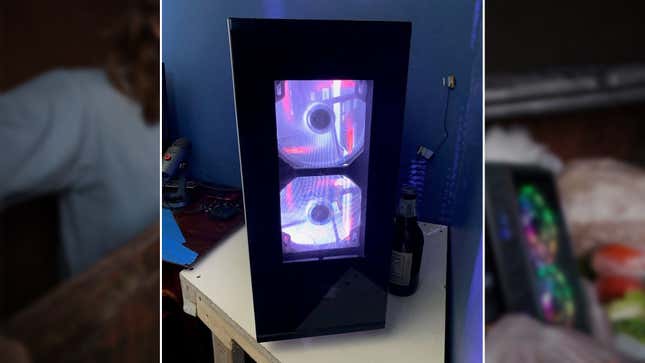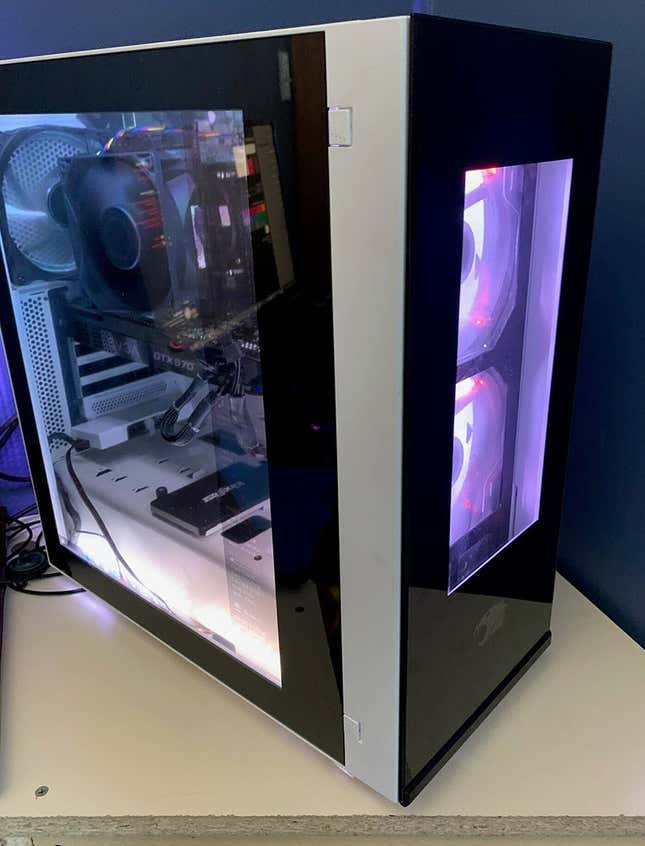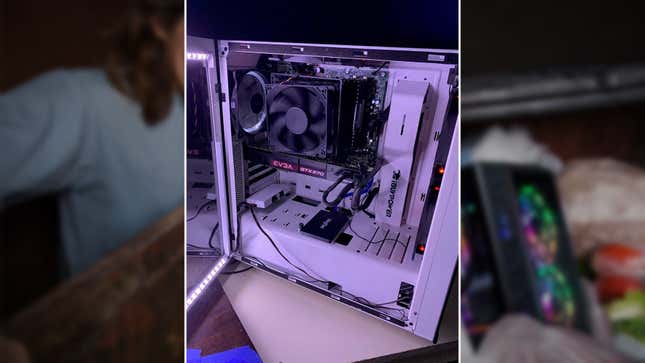Dumpster divers find all kinds of things in the trash. From a full pallet of cold brew coffee to hundreds of metal tins for Yu-Gi-Oh cards, there’s no shortage of cool stuff buried in the heaps of garbage you’ll likely find in the bin. But while some of it may be useless, redditor Rydirp7 took the saying “one man’s trash is another man’s treasure” to heart and built a whole PC out of discarded computer parts.
It’s no secret that electronics aren’t as recyclable as other materials, like certain types of fabrics, glass, metals, and plastics. According to a 2019 UN report, about 50 million tons of electronic waste (e-waste) is produced every year globally, with only 20 percent of it formally recycled. This means the other 80 percent—which equals an annual value of $62.5 billion—either gets shipped off to a landfill or is “informally recycled,” the process of throwing away unwanted things in the trash that can end up in poorer communities, which results in environmental contamination and hazardous health impacts. This is where dumpster divers, or folks who dig through the garbage to find cool or interesting stuff, can alleviate the strain by repurposing what was unused into something actually usable.
Rydirp7 did just that recently, posting his trash PC build on the popular subreddit r/DumpsterDiving and revealing that he only bought two components for the custom-built machine. The rest, from the graphics card to the processing chip, were found in a local dumpster. One redditor said it was “amazing.” Another user said they have “mad respect for people” like him. Most in the comments simply congratulated him on the build and hopes he keeps it up. Kotaku reached out to Rydirp7 to learn about the process behind building a trash PC and the benefits of looking in the garbage for gaming setups.
Dumpster diving for PC parts
Rydirp7, who is a resident of South Dakota, said he was inspired by the stuff he heard about dumpster diving online, and in the summer of 2022, thought he’d give the activity a shot. He visited a local computer store in his town “in the middle of nowhere” to see if he could find some things and was quite surprised by his discoveries.
“There was some stuff there,” Rydirp7 told Kotaku in a phone interview. “Ever since, I occasionally check the store’s dumpster and yeah, with that PC that you saw in the Reddit post, it was built almost entirely using parts pulled out of that dumpster over the course of like six or seven months.”
The only components he bought were the power supply and RAM, which came out to approximately $120 in total. Rydirp7 said these two parts were already in his possession as he purchased them for a different computer but figured he’d reuse them for this build since they were just lying around his home. Interestingly, he ran into an issue with the graphics card he found, as it was a 10-year-old EVGA GeForce GTX 570. While it “runs games decently,” he had to extensively troubleshoot it because “the drivers wouldn’t install correctly.”

After countless hours of trying to fix the graphics card, he decided it was time to just bake the thing in the oven. Seriously. This is known as the oven trick in the PC community and, as Rydirp7 put it, the card’s been working fine ever since.
“Essentially what the oven trick is is you take off pretty much everything from the graphics card,” Rydirp7 said. “The heat sink, the shroud—basically, you strip it down to the bare PCB and then what you do is wrap it in aluminum foil to help protect some of the more sensitive components on the PCB. You preheat the oven to somewhere around 400 degrees Fahrenheit, then put the graphics card, or whatever electronic it is that you’re trying to fix, in the oven. It’s typically like 8 to 12 minutes for a graphics card, I believe. But yeah, that’s basically the oven trick. I’ve done this on two different graphics cards: The other one was a GTX 240 and then this GTX 570, and the trick has worked both times for me.”
Baking the graphics card like a cookie in the oven works because faulty connections due to loose or old soldering joints are re-melted, allowing the power to reconnect and flow back through what are likely broken points.
The challenges of building a trash PC
Rydirp7 admits he’s “a bit of a hoarder when it comes to PC parts,” so this trash PC was actually the second one he built out of garbage components. The first one—which had an AMD FX 6300 CPU, 8GB of RAM, that GTX 240, and a 500-watt power supply—went to one of his friends a while back. While he said his first attempt at a trash PC was perfectly serviceable this second one is “quite a bit better,” because it houses double the RAM and outputs more power. However, one of the most challenging components to find for the build was the 256GB SSD.

“The SSD was the last part I found,” Rydirp7 said. “I had been checking the dumpster for months and months but couldn’t ever find anything. When there was something, it was like a hard drive that was already disassembled. Initially when I found this SSD, I thought it was a new one that didn’t have any data on it. But when I got the SSD hooked up to the system to install Windows 10, it turned out that it actually wasn’t new and had someone else’s data on it. So what I do when I find a part that has someone else’s data on it is immediately wipe it for the privacy of the previous owner because it’s none of my business.”
Meanwhile, the Dell OptiPlex 9010 motherboard was one of the first components Rydirp7 pulled out of his local computer store’s garbage. Unlike the graphics card and SSD, this part worked fine and didn’t need to be tinkered with. He said the store, which he wouldn’t disclose the name or location of for privacy reasons, “mostly throws out older hardware” that’s still functional. It’s thanks to this store that he was able to build what has become his “main rig.” While he doesn’t play a whole lot of games, he listed a few that he plays regularly, noting that his trash PC “can get a little warm” when he’s gaming.
“It could probably play Crysis,” Rydirp7 said. “But yeah, I don’t actually play a whole lot of games. The only stuff I really play is Minecraft, Roblox, and Scrap Mechanic. That’s about it, and my PC runs all of those games fairly well.”
The benefits of building a trash PC
Building trash PCs is one way for combatting the roughly 70 percent of e-waste that Americans produce, Rydirp7 said, acknowledging the frequency with which most people’s old electronics end up in landfills.
“This tactic of building trash PCs from garbage components keeps perfectly usable electronics from going into landfills,” Rydirp7 said. “It can be easy for someone to build a computer with little to no money invested in it.”
As far as the viability of the trash PC, well, it depends on what you can find and how you’re going to use it. It’s more than capable of performing your everyday tasks, like writing emails and watching YouTube, another thing Rydirp7 said he frequently does on this computer. But as my colleague Claire Jackson said, “In 2010, this was a nice rig!”

In 2023, these aren’t the ideal components for playing more modern games with 4K visuals and ray tracing. Rydirp7 may be able to get away with running Crysis on his trash PC, especially since Crytek’s sci-fi FPS has been optimized to run on the Nintendo Switch these days. But it’s highly unlikely he could play Cyberpunk 2077 or any of the PlayStation games—like Days Gone or God of War—that made the jump to PC.
Still, to each their own. And you can’t complain much when you’ve only spent a cool $120 on something that could run most indies and Xbox 360-era games. That’s not a bad trade-off, especially if you don’t play that many games to begin with. You can check out Rydirp7’s trash PC specs below:
- EVGA GTX 570 Graphics Card
- Intel Core I7-3770 Non-K Processor
- 16GB Corsair Vengeance RAM at 1600mhz
- 750-watt Corsair Power Supply
- iBUYPOWER Snowblind Element Case
- Dell OptiPlex 9010 Motherboard
While it may not be the most powerful PC in the world, what actually makes this PC stronger than most is the fact that it was built sustainably in the most literal definition of the phrase. By recycling and reusing old computer components, turning them into a functional Frankenstein PC, Rydirp7 has has figured out a way to reduce his overall environmental footprint. I can’t speak to his energy consumption’s impact on the world, but building trash PCs could go a long way in minimizing global e-waste.
























